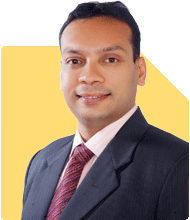Ramalingam Kalirajan |6505 Answers |Ask -Follow
Mutual Funds, Financial Planning Expert - Answered on Jul 06, 2024
He has an MBA in finance from the University of Madras and is a certified financial planner.
He is the director and chief financial planner at Holistic Investment, a Chennai-based firm that offers financial planning and wealth management advice.... more

My income is 1.25 l and My wife is 40k with age of 43 yrs both. child is 14 years. I am civil engineer working in private company. and my wife computer engineer is working in Government on contract but it is renew every year. now it is continue for 3 years. I bough 4 house now value is 1.5 cr. PF value is 14l now. Investment in MF and stock 25 lacs and now value is 45 lacs. My wife has one PLI scheme will close next year May24. Will get 8l. one Unit link SIP will finished on jan25. will got 4 l. I have Mediclaim from employer 15l. I have two unitlike insurance of bajaj alliance. Its market value is 14 lacs and insured amount is 31 lacs. paid premium of 1.11 lacs from one policy to other. Gold approx 500 gms.i got rent around 30l from my properties. My city is silvassa .Its not big city but not village. My expences is 2 lacs per annum on child study. SIP 10 thousand. invest instock 25000 k every month. My misc. expences is approx. My misc. monthly expences is 35k appox. cash 2 l only .I have loan pending is worth 8l and EMI is 33k for next 2.5 yr. Please suggest me what to do for future planning in terms of retirement planning, post retirement health insurance, Post Mediclaim policy, child study. as We want to quit job after next 7 years at the age of 50. avg. tour and travelling is expense every year 1l. Sir. Please suggest me. Sejal Chauhan Silvassa Ut of DD and DNH.
Current Financial Snapshot
Income:
Your income: Rs. 1.25 lakhs per month.
Wife's income: Rs. 40,000 per month.
Rental income: Rs. 30 lakhs annually.
Expenses:
Child’s education: Rs. 2 lakhs per annum.
SIP: Rs. 10,000 per month.
Stock investments: Rs. 25,000 per month.
Miscellaneous expenses: Rs. 35,000 per month.
EMI: Rs. 33,000 for 2.5 years.
Assets:
4 houses valued at Rs. 1.5 crores.
PF: Rs. 14 lakhs.
Mutual funds and stocks: Rs. 45 lakhs.
Wife's PLI scheme maturing in May 2024: Rs. 8 lakhs.
ULIP maturing in Jan 2025: Rs. 4 lakhs.
Mediclaim from employer: Rs. 15 lakhs.
Two ULIP policies with Bajaj Allianz: Market value Rs. 14 lakhs, insured amount Rs. 31 lakhs.
Gold: 500 grams.
Cash: Rs. 2 lakhs.
Liabilities:
Pending loan: Rs. 8 lakhs with an EMI of Rs. 33,000 for 2.5 years.
Retirement Planning
1. Assessing Retirement Corpus:
You plan to retire at 50. Considering your current lifestyle, we need to estimate the corpus required to maintain it post-retirement. This includes covering expenses, healthcare, and any other planned activities.
2. Current Investments:
Your current investments in PF, mutual funds, stocks, and real estate are significant. They provide a solid foundation for your retirement corpus. Ensure to continue your SIPs and stock investments as they are performing well.
3. Maximizing PF and PLI:
Your PF and PLI schemes will provide a good lump sum on maturity. Use these funds wisely to either pay off remaining liabilities or reinvest in safer options for retirement.
4. Reinvesting ULIP Maturities:
The ULIP maturity amounts in 2024 and 2025 should be reinvested in diversified mutual funds. This can offer better returns compared to reinvesting in another ULIP.
Post-Retirement Health Insurance
1. Mediclaim Continuation:
You have a mediclaim policy from your employer, but post-retirement, you will need a personal health insurance plan. Start looking for a comprehensive health insurance policy now to cover you and your family post-retirement.
2. Critical Illness Coverage:
Consider adding critical illness coverage to your health insurance. This ensures financial support in case of serious health issues which may require expensive treatments.
Managing Current Expenses
1. Education Expenses:
Your child's education expenses are significant. Plan for future educational needs, including college expenses. Start an education fund if you haven’t already.
2. EMI and Loan Management:
You have an EMI of Rs. 33,000 for the next 2.5 years. Focus on clearing this loan as soon as possible. Utilize any bonus or additional income to prepay this loan, reducing the interest burden.
3. Miscellaneous Expenses:
Your monthly miscellaneous expenses are Rs. 35,000. Review these expenses to identify any areas where you can cut costs. This will help in increasing your savings rate.
Building a Robust Investment Portfolio
1. Diversified Mutual Funds:
Continue investing in diversified mutual funds. They offer good returns and lower risk compared to sector-specific funds. Use the SIP route to invest regularly and benefit from rupee cost averaging.
2. Balanced Approach:
Maintain a balanced portfolio with a mix of equity and debt funds. This reduces risk and provides stable returns. Equity funds for growth and debt funds for stability.
3. Avoid Overexposure to ULIPs:
ULIPs have higher charges and may not provide the best returns. Reassess the value and benefits of your existing ULIPs. Consider surrendering them if the returns are not satisfactory and reinvest in mutual funds.
Power of Compounding
1. Long-Term Growth:
The power of compounding works best with long-term investments. Your mutual funds and SIPs will benefit from this, leading to substantial growth over time.
2. Regular Investments:
Continue your regular investments in SIPs and stocks. Even small amounts invested consistently will grow significantly due to compounding.
Advantages of Mutual Funds
1. Professional Management:
Mutual funds are managed by professional fund managers. They make informed decisions to maximize returns while managing risks.
2. Diversification:
Mutual funds offer diversification, spreading your investment across various assets. This reduces risk and enhances potential returns.
3. Liquidity:
Mutual funds are highly liquid. You can redeem your units anytime, providing flexibility in case of financial needs.
Actively Managed Funds vs. Index Funds
1. Active Management Benefits:
Actively managed funds aim to outperform the market. Fund managers make strategic decisions based on market conditions, potentially offering higher returns.
2. Index Funds Limitations:
Index funds simply track a market index. They do not aim to outperform it. Actively managed funds can adjust holdings and strategies to maximize returns.
Sejal, mutual funds (MFs) can play a pivotal role in meeting your children's education goals and your retirement planning. They offer various advantages such as diversification, professional management, and the power of compounding, making them a valuable addition to any financial plan.
Importance of Mutual Funds in Meeting Kids' Education Goals
1. Systematic Investment Plans (SIPs):
SIPs allow you to invest a fixed amount regularly in mutual funds. This disciplined approach helps in building a substantial corpus over time. For your child's education, starting a SIP early can make a significant difference due to the power of compounding.
2. Goal-Based Investing:
Mutual funds offer a variety of schemes catering to different goals. You can choose funds based on the timeline and risk profile suitable for your child's education needs. For instance, equity funds for long-term growth and balanced or debt funds for short-term stability.
3. Diversification:
Mutual funds invest in a diversified portfolio of assets, which helps in mitigating risks. By investing in a mix of equity, debt, and hybrid funds, you can ensure that your investments are not overly exposed to market volatility, thereby protecting your child's education fund.
4. Tax Efficiency:
Certain mutual funds, such as Equity-Linked Savings Schemes (ELSS), offer tax benefits under Section 80C of the Income Tax Act. Investing in these funds not only helps in wealth creation but also provides tax savings, making them an efficient option for education planning.
5. Flexibility:
Mutual funds offer the flexibility to start or stop SIPs, redeem units, or switch between funds based on your financial situation and goals. This adaptability ensures that you can adjust your investments as per the changing needs and milestones of your child's education.
6. Professional Management:
Mutual funds are managed by professional fund managers who make informed decisions based on extensive research and market analysis. This expertise can help in generating better returns compared to individual stock picking, ensuring a steady growth of your education fund.
Importance of Mutual Funds in Retirement Planning
1. Long-Term Growth:
Retirement planning requires a long-term investment horizon. Equity mutual funds, in particular, have the potential to deliver higher returns over the long term, thanks to the power of compounding. Starting early and staying invested can significantly enhance your retirement corpus.
2. Regular Income:
Post-retirement, you will need a regular income to maintain your lifestyle. Mutual funds, especially debt funds and hybrid funds, can provide a steady stream of income through systematic withdrawal plans (SWPs) or dividend options, ensuring financial stability during retirement.
3. Inflation Protection:
One of the biggest challenges in retirement planning is inflation. Equity mutual funds, with their potential for higher returns, can help in beating inflation over the long term. By allocating a portion of your retirement corpus to equity funds, you can ensure that your purchasing power is maintained.
4. Diversification:
Diversification is crucial in retirement planning to balance risk and return. Mutual funds offer a range of options, including equity, debt, and balanced funds, allowing you to create a diversified portfolio that suits your risk appetite and retirement goals.
5. Tax Efficiency:
Investing in mutual funds can be tax-efficient for retirement planning. Long-term capital gains from equity mutual funds are taxed at a lower rate, and certain funds offer tax-saving benefits. This tax efficiency helps in maximizing your retirement corpus.
6. Liquidity:
Mutual funds are highly liquid investments. You can redeem your investments partially or fully at any time, providing flexibility to meet unforeseen expenses during retirement. This liquidity ensures that you are not locked into investments and can access your funds when needed.
7. Ease of Management:
Mutual funds simplify the process of retirement planning. You can automate your investments through SIPs, and professional fund managers take care of the portfolio management. This ease of management allows you to focus on other aspects of your life without worrying about your investments.
Mutual Funds for Kids' Education Goals
1. Starting Early:
The earlier you start investing for your child's education, the more time your money has to grow. For example, if you start a SIP when your child is born, you have around 18 years to build a substantial education corpus.
2. Choosing the Right Funds:
For long-term goals like education, equity mutual funds are ideal due to their higher return potential. As the time to goal reduces, you can gradually shift to balanced or debt funds to reduce risk and protect the accumulated corpus.
3. Education Planning:
Estimate the future cost of education, considering factors like inflation and the type of education your child might pursue. Based on this estimate, you can calculate the required monthly investment in mutual funds to achieve this goal.
4. Reviewing and Rebalancing:
Regularly review your investment portfolio to ensure it is on track to meet your education goal. Rebalance the portfolio periodically to maintain the desired asset allocation and adjust for market changes.
Mutual Funds for Retirement Planning
1. Retirement Corpus Estimation:
Estimate your retirement corpus by considering your current expenses, future lifestyle, inflation, and life expectancy. This will give you a target amount to aim for through your mutual fund investments.
2. Asset Allocation:
Determine an asset allocation strategy based on your risk tolerance and time to retirement. A mix of equity and debt mutual funds can provide growth and stability to your retirement corpus.
3. SIPs and Lumpsum Investments:
Invest regularly through SIPs to take advantage of rupee cost averaging and market volatility. Additionally, invest any lump sum amounts (bonuses, maturity proceeds) in mutual funds to boost your retirement savings.
4. Withdrawal Strategy:
Plan a systematic withdrawal strategy to ensure a steady income post-retirement. This could involve setting up SWPs from your mutual fund investments or redeeming units periodically based on your cash flow needs.
5. Healthcare Costs:
Include healthcare costs in your retirement planning. As you age, medical expenses are likely to increase. Ensure that you have sufficient coverage through health insurance and allocate a portion of your retirement corpus to meet these expenses.
Importance of Certified Financial Planners (CFPs)
1. Personalized Advice:
A CFP provides personalized financial advice based on your goals and risk tolerance. They can help you build a tailored financial plan.
2. Comprehensive Planning:
CFPs consider all aspects of your financial situation, including investments, insurance, retirement, and estate planning.
3. Peace of Mind:
Working with a CFP gives you peace of mind. You know your financial future is in the hands of a professional who prioritizes your best interests.
Final Insights
Sejal, you have a strong financial foundation with diversified investments. Focus on managing your current liabilities and continue your disciplined investment approach. Ensure you have adequate health insurance post-retirement and a clear plan for your child’s education. Consulting a Certified Financial Planner can provide you with personalized advice and help you achieve your financial goals.
Best Regards,
K. Ramalingam, MBA, CFP
Chief Financial Planner
www.holisticinvestment.in
Best Regards,
K. Ramalingam, MBA, CFP,
Chief Financial Planner,
www.holisticinvestment.in
You may like to see similar questions and answers below
Ramalingam Kalirajan |6505 Answers |Ask -Follow
Mutual Funds, Financial Planning Expert - Answered on May 14, 2024
Ramalingam Kalirajan |6505 Answers |Ask -Follow
Mutual Funds, Financial Planning Expert - Answered on May 27, 2024
Ramalingam Kalirajan |6505 Answers |Ask -Follow
Mutual Funds, Financial Planning Expert - Answered on Jul 15, 2024
Ramalingam Kalirajan |6505 Answers |Ask -Follow
Mutual Funds, Financial Planning Expert - Answered on Oct 05, 2024
Moneywize |164 Answers |Ask -Follow
Financial Planner - Answered on Oct 05, 2024
Milind Vadjikar |317 Answers |Ask -Follow
Insurance, Stocks, MF, PF Expert - Answered on Oct 05, 2024
Milind Vadjikar |317 Answers |Ask -Follow
Insurance, Stocks, MF, PF Expert - Answered on Oct 05, 2024
Ramalingam Kalirajan |6505 Answers |Ask -Follow
Mutual Funds, Financial Planning Expert - Answered on Oct 05, 2024
Dr Dipankar Dutta |653 Answers |Ask -Follow
Tech Careers and Skill Development Expert - Answered on Oct 04, 2024
Krishna Kumar |377 Answers |Ask -Follow
Workplace Expert - Answered on Oct 04, 2024
Krishna Kumar |377 Answers |Ask -Follow
Workplace Expert - Answered on Oct 04, 2024
Krishna Kumar |377 Answers |Ask -Follow
Workplace Expert - Answered on Oct 04, 2024
Krishna Kumar |377 Answers |Ask -Follow
Workplace Expert - Answered on Oct 04, 2024


























